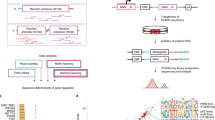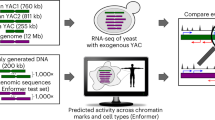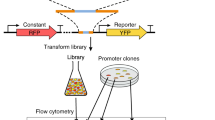Abstract
DNA-binding transcriptional regulators interpret the genome's regulatory code by binding to specific sequences to induce or repress gene expression1. Comparative genomics has recently been used to identify potential cis-regulatory sequences within the yeast genome on the basis of phylogenetic conservation2,3,4,5,6, but this information alone does not reveal if or when transcriptional regulators occupy these binding sites. We have constructed an initial map of yeast's transcriptional regulatory code by identifying the sequence elements that are bound by regulators under various conditions and that are conserved among Saccharomyces species. The organization of regulatory elements in promoters and the environment-dependent use of these elements by regulators are discussed. We find that environment-specific use of regulatory elements predicts mechanistic models for the function of a large population of yeast's transcriptional regulators.
This is a preview of subscription content, access via your institution
Access options
Subscribe to this journal
Receive 51 print issues and online access
$199.00 per year
only $3.90 per issue
Buy this article
- Purchase on Springer Link
- Instant access to full article PDF
Prices may be subject to local taxes which are calculated during checkout




Similar content being viewed by others
References
Jacob, F. & Monod, J. Genetic regulatory mechanisms in the synthesis of proteins. J. Mol. Biol. 3, 318–356 (1961)
Kellis, M., Patterson, N., Endrizzi, M., Birren, B. & Lander, E. S. Sequencing and comparison of yeast species to identify genes and regulatory elements. Nature 423, 241–254 (2003)
Cliften, P. et al. Finding functional features in Saccharomyces genomes by phylogenetic footprinting. Science 301, 71–76 (2003)
Pritsker, M., Liu, Y. C., Beer, M. A. & Tavazoie, S. Whole-genome discovery of transcription factor binding sites by network-level conservation. Genome Res. 14, 99–108 (2004)
Wang, T. & Stormo, G. D. Combining phylogenetic data with co-regulated genes to identify regulatory motifs. Bioinformatics 19, 2369–2380 (2003)
Blanchette, M. & Tompa, M. FootPrinter: A program designed for phylogenetic footprinting. Nucleic Acids Res. 31, 3840–3842 (2003)
Iyer, V. R. et al. Genomic binding sites of the yeast cell-cycle transcription factors SBF and MBF. Nature 409, 533–538 (2001)
Ren, B. et al. Genome-wide location and function of DNA binding proteins. Science 290, 2306–2309 (2000)
Lee, T. I. et al. Transcriptional regulatory networks in Saccharomyces cerevisiae. Science 298, 799–804 (2002)
Lieb, J. D., Liu, X., Botstein, D. & Brown, P. O. Promoter-specific binding of Rap1 revealed by genome–wide maps of protein-DNA association. Nature Genet. 28, 327–334 (2001)
Roth, F. P., Hughes, J. D., Estep, P. W. & Church, G. M. Finding DNA regulatory motifs within unaligned noncoding sequences clustered by whole-genome mRNA quantitation. Nature Biotechnol. 16, 939–945 (1998)
Liu, X. S., Brutlag, D. L. & Liu, J. S. An algorithm for finding protein-DNA binding sites with applications to chromatin-immunoprecipitation microarray experiments. Nature Biotechnol. 20, 835–839 (2002)
Bailey, T. L. & Elkan, C. Proc. Int. Conf. Intell. Syst. Mol. Biol. Vol. 3 21–29 (AAAI Press, Menlo Park, California, 1995)
Knuppel, R., Dietze, P., Lehnberg, W., Frech, K. & Wingender, E. TRANSFAC retrieval program: a network model database of eukaryotic transcription regulating sequences and proteins. J. Comput. Biol. 1, 191–198 (1994)
Cunningham, T. S. & Cooper, T. G. The Saccharomyces cerevisiae DAL80 repressor protein binds to multiple copies of GATAA-containing sequences (URSGATA). J. Bacteriol. 175, 5851–5861 (1993)
Donahue, T. F., Daves, R. S., Lucchini, G. & Fink, G. R. A short nucleotide sequence required for regulation of HIS4 by the general control system of yeast. Cell 32, 89–98 (1983)
Kirkpatrick, C. R. & Schimmel, P. Detection of leucine-independent DNA site occupancy of the yeast Leu3p transcriptional activator in vivo. Mol. Cell. Biol. 15, 4021–4030 (1995)
Axelrod, J. D., Majors, J. & Brandriss, M. C. Proline-independent binding of PUT3 transcriptional activator protein detected by footprinting in vivo. Mol. Cell. Biol. 11, 564–567 (1991)
Ma, J. & Ptashne, M. The carboxy-terminal 30 amino acids of GAL4 are recognized by GAL80. Cell 50, 137–142 (1987)
Beck, T. & Hall, M. N. The TOR signalling pathway controls nuclear localization of nutrient-regulated transcription factors. Nature 402, 689–692 (1999)
Chi, Y. et al. Negative regulation of Gcn4 and Msn2 transcription factors by Srb10 cyclin-dependent kinase. Genes Dev. 15, 1078–1092 (2001)
Albrecht, G., Mosch, H. U., Hoffmann, B., Reusser, U. & Braus, G. H. Monitoring the Gcn4 protein-mediated response in the yeast Saccharomyces cerevisiae. J. Biol. Chem. 273, 12696–12702 (1998)
Kornitzer, D., Raboy, B., Kulka, R. G. & Fink, G. R. Regulated degradation of the transcription factor Gcn4. EMBO J. 13, 6021–6030 (1994)
Zeitlinger, J. et al. Program-specific distribution of a transcription factor dependent on partner transcription factor and MAPK signaling. Cell 113, 395–404 (2003)
Baur, M., Esch, R. K. & Errede, B. Cooperative binding interactions required for function of the Ty1 sterile responsive element. Mol. Cell. Biol. 17, 4330–4337 (1997)
Waterston, R. H. et al. Initial sequencing and comparative analysis of the mouse genome. Nature 420, 520–562 (2002)
Matys, V. et al. TRANSFAC: transcriptional regulation, from patterns to profiles. Nucleic Acids Res. 31, 374–378 (2003)
Hodges, P. E., McKee, A. H., Davis, B. P., Payne, W. E. & Garrels, J. I. The Yeast Proteome Database (YPD): a model for the organization and presentation of genome-wide functional data. Nucleic Acids Res. 27, 69–73 (1999)
Zhu, J. & Zhang, M. Q. SCPD: a promoter database of the yeast Saccharomyces cerevisiae. Bioinformatics 15, 607–611 (1999)
Schneider, T. D. & Stephens, R. M. Sequence logos: a new way to display consensus sequences. Nucleic Acids Res. 18, 6097–6100 (1990)
Acknowledgements
We thank T. Ideker and S. McCuine for help in selecting regulators to study in environmental conditions; E. Herbolsheimer, G. Bell, R. Latek and F. Lewitter for computational assistance; and E. McReynolds for technical assistance. E.F. is a Whitehead Fellow and was funded in part by Pfizer. D.B.G. was supported by a NIH/NIGMS NRSA award. This work was supported by an NIH grant.
Author information
Authors and Affiliations
Corresponding authors
Ethics declarations
Competing interests
Some authors have filed a patent application covering aspects of this work and are pursuing commercialization.
Supplementary information
Supplementary Figures 1-5
These figures show distributions of regulator binding, an overview of our motif-discover process, an example of in vitro regulator binding, the effect of environmental conditions on genomic binding, and a change in the quality of Gcn4 binding sites in different environmental conditions. (PDF 2001 kb)
Supplementary Tables 1-8
These tables list the regulators and environmental conditions examined, a comparison of discovered motifs to literature, the compendium of regulator specificities, characterizations of regulator architectures, a classification of regulator binding behaviours, and motif scoring metrics. (DOC 135 kb)
Supplementary Methods
This file contains additional information about all aspects of experimental procedures used. (DOC 72 kb)
Rights and permissions
About this article
Cite this article
Harbison, C., Gordon, D., Lee, T. et al. Transcriptional regulatory code of a eukaryotic genome. Nature 431, 99–104 (2004). https://doi.org/10.1038/nature02800
Received:
Accepted:
Issue Date:
DOI: https://doi.org/10.1038/nature02800
This article is cited by
-
Genome-wide expression QTL mapping reveals the highly dynamic regulatory landscape of a major wheat pathogen
BMC Biology (2023)
-
Slowest first passage times, redundancy, and menopause timing
Journal of Mathematical Biology (2023)
-
Biological Codes: A Field Guide for Code Hunters
Biological Theory (2023)
-
Consensus clustering for Bayesian mixture models
BMC Bioinformatics (2022)
-
NetREX-CF integrates incomplete transcription factor data with gene expression to reconstruct gene regulatory networks
Communications Biology (2022)
Comments
By submitting a comment you agree to abide by our Terms and Community Guidelines. If you find something abusive or that does not comply with our terms or guidelines please flag it as inappropriate.



